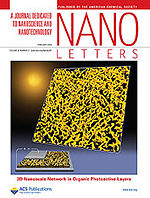- Nano Letters
-
Nano Letters 
Abbreviated title (ISO) Nano Lett. Discipline Nanoscience, nanotechnology, materials science, chemistry Language English Edited by A. Paul Alivisatos & Charles M. Lieber Publication details Publisher American Chemical Society (United States) Publication history 2001–present Frequency Monthly Impact factor
(2010)12.219 Indexing ISSN 1530-6984 (print)
1530-6992 (web)LCCN 00215436 CODEN NALEFD Links Nano Letters is a monthly, peer-reviewed, scientific journal, published by the American Chemical Society. It was first published in January 2001. The two Co-Editors-in-Chief are A. Paul Alivisatos (University of California, Berkeley) and Charles M. Lieber (Harvard University). The 2010 impact factor for Nano Letters is 12.219, according to the Journal Citation Reports.[1]
Contents
Scope
The focus of the journal is rapid dissemination of selected elements regarding fundamental, original research reports on all topics related to the theory and practice of nanoscience, nanotechnology, and their subdisciplines. Physical, chemical, and biological phenomena related to nanoscience and nanotechnology are part of this focus. Furthermore nanoscale materials science is also included, focusing on processes and applications of structures at this size.[1] Subject coverage encompasses the following: Materials that are synthesized and processed by physical, chemical, and biological methods. The classes of these materials are organic, inorganic, and hybrid. Furthermore, these processes are subjects of modeling and simulation. Specifically these process range from synthesis to assembly, along with relevant interactions.[1]
Also of interest for this journal is the characterization of materials properties at the scales being studied during the research endeavor. Results also produce realization and application of novel nanostructures and nanodevices.[1]
Abstracting and indexing
Nano Letters is currently indexed in Chemical Abstracts Service, CASSI, Scopus, EBSCOhost, British Library, PubMed, and Web of Science.[1]
See also
- Nature Photonics
- Nature Nanotechnology
- Journal of Nanoscience and Nanotechnology
- International conference on Physics of Light-Matter Coupling in Nanostructures
- Journal of Nanoparticle Research
- NANO
References
- ^ a b c d e "About this journal". Nano Letters. American Chemical Society. August 2010. http://pubs.acs.org/page/nalefd/about.html. Retrieved 2010-08-07.
Categories:- American Chemical Society academic journals
- Nanotechnology journals
- Publications established in 2001
- Monthly journals
- English-language journals
Wikimedia Foundation. 2010.
